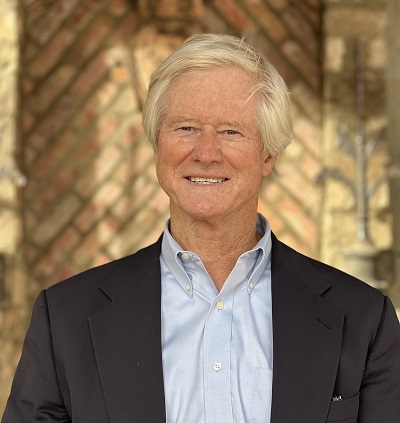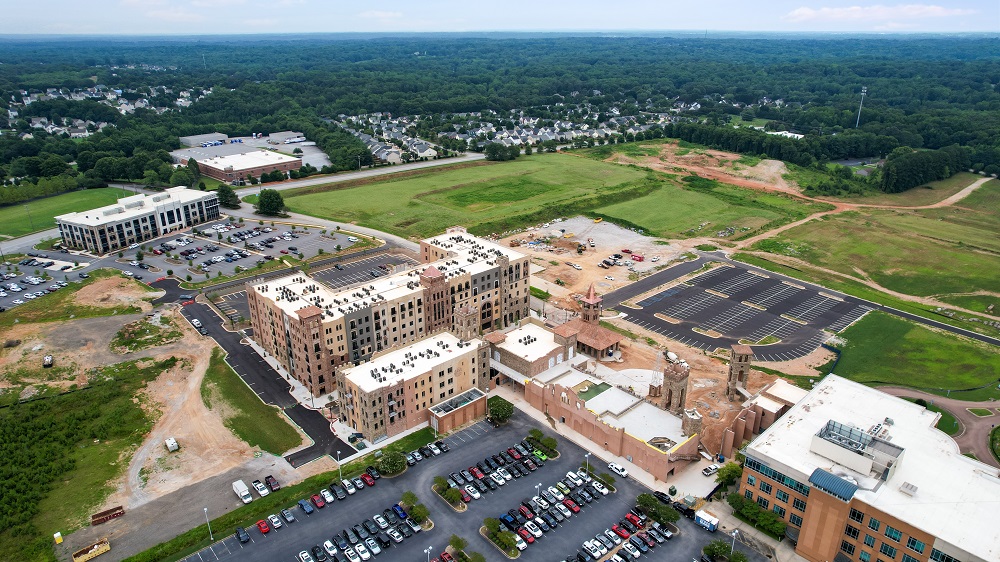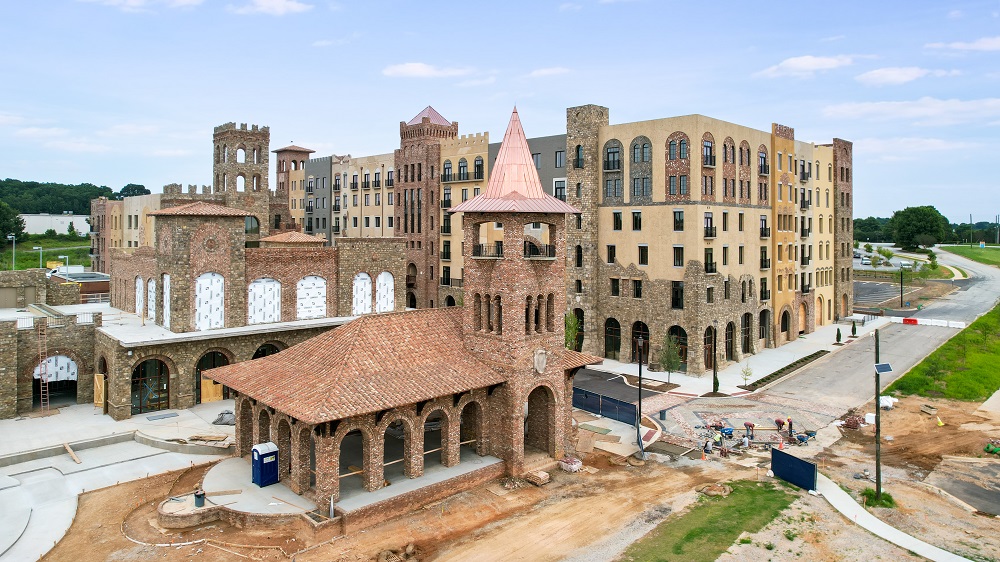
A Taste of Italy in South Carolina: A Developer’s Journey
Following a long journey with many twists and turns, Hughes Investments’ BridgeWay Station mixed-use development has become a reality. Several large office tenants, commercial tenants, and a school are already open, and over 100 new apartments are leased and occupied. Several more restaurants and commercial tenants will open over the next few months. Visible from I-385, just south of Greenville, S.C., this unique “town center-style” community comprising close to 1,000,000 square feet, is expected to serve as a catalyst for driving growth and innovation – shaping the future of commercial real estate and construction in the Upstate region of the state.
GroundBreak Carolinas caught up with Phil Hughes, Founder and President of Hughes Investments, to gain insight into the past, present and future of this new development that appears to have “endless possibilities.”

Things started off well in 1983 with a development that was initially planned to be an industrial park in Mauldin, S.C. called Centerpointe. However, soon after you started grading the land, there was a sewer moratorium that halted everything. You kept buying more land on the site, but not much else happened for decades. What spurred you onward when others might have felt like giving up?
Yes, the sewer moratorium caused a significant delay in the development of the industrial park. However, this setback ultimately turned out to be a blessing in disguise, as it unveiled the tremendous growth that was on the horizon for the Upstate area. The age-old saying, “You don’t pick an apple until it’s ripe,” applies in this situation. It became clear to me that exercising patience would result in greater opportunities to better serve the community with a unique New Town Center like BridgeWay Station.
Additionally, with each new parcel of land acquired, fresh developments emerged. This included the construction of facilities for notable organizations like Prisma Health, Jackson Marketing, Dodge, Samsung (now the GREEN Upstate Charter High School), and various others.
Most developers sell a property for a profit after development. It’s a little unusual for a developer to continue to own and manage a property after it’s been developed. Why have you taken that approach with your developments?
We have always been a rather small office, and we have been fortunate to work with great clients and enjoy every aspect of “ground-up” development. Our journey has been a day-by-day process, partnering with exceptional clients in a thriving market. And we still believe in a bright future and the benefits of combining scalability with active, hands-on participation in every stage of a building’s life. We’re aiming for sustained success if we can execute it correctly!
One personality trait of a developer is creativity. Talk about the creativity required by your company to launch BridgeWay Station.
If imitation is the greatest form of flattery, then the Italians should feel very flattered! Simply stated, we love and are inspired by the old historic building styles of Old Europe, and we are trying to bring that proven beauty to our hometown in an authentic way. Of course, there are limitations and many difficult compromises, but overall, the outcome has been very well accepted. At BridgeWay, we employed a construction method known as tilt-up construction, which is typically associated with industrial properties. This approach allowed us to efficiently save both time and resources. The masons, in particular, have surpassed expectations in crafting exquisite exteriors with intricate details, giving the project an impressive appearance. The collective effort of everyone involved has played a vital role in bringing this project to life with a distinctive “old world” charm.
Developers usually take a big risk in the construction process. How risky was BridgeWay Station compared to other projects you’ve done?
In some ways there is little risk, but in others it’s a very big risk. The market data of the surrounding area is incredible. There is high traffic volume on I-385 and extreme growth patterns in Mauldin, Five Forks, Simpsonville, Fountain Inn and the entire region. The fundamentals are very, very solid. We believe there are many people in this growing area that will enjoy the mixture of uses and fun activities we are planning in this walkable, beautiful project. On the other hand, we had to create new engineering and construction techniques to stay within (or close to) our budget. This has not been easy, but we are pleased with the results and hope everyone enjoys the outcome.
Talk about the teamwork that’s been instrumental to the project – from the architect McMillan Pazdan Smith, to Harper General Contractors, and the government entities.
These partners, along with Johnston Design Group, Eric Brown, United Infrastructure Group, specialty masons and others, have been instrumental. Yes, this is a complex undertaking with multiple contractors and subcontractors all operating within a compact, pedestrian-friendly layout, much like any downtown setting. But they have coordinated and scheduled their work very efficiently and effectively. The city of Mauldin has truly been an indispensable partner, acting more like a collaborator than a bureaucratic entity right from the outset. It’s truly remarkable how consistently supportive and cooperative Mauldin has been – and continues to be – throughout this process.
It took a lot of coordination and trust for a developer and government agencies to come together to make a project of this scope happen. Expand on that.
The leadership of Mauldin has exceeded all expectations as they worked with Greenville County to help with numerous infrastructure issues to make this all possible. Their “form-based” zoning has worked flawlessly as we planned the entire development, and their approach and success in building the Swamp Rabbit Trail pedestrian bridge over I-385 has been so incredible to watch unfold – a truly iconic amenity that’s accessible and enjoyable for all. Mauldin has a “How can we help?” attitude that makes all the difference.
You’ve traveled to Italy. Which cities made an impression on you that you’re trying to model at BridgeWay Station?
The beautiful old buildings and towers are so prolific all across Italy that it’s hard to limit this answer to just a few, but naturally Florence and Rome, as well as Sienna, Assisi, and San Gimignano immediately spring to mind. We’ve built arches everywhere, constructed multiple spiring towers, and adorned buildings with embellishments scattered all around, which we affectionately refer to as the project’s “eye candy.” The use of natural stone and the intentionally “imperfectly perfect” construction and design infuse a genuine warmth and allure that is a rarity in our more modern, commercial world.
Tell us about some of the unique materials from Italy that were used in the construction.
The terra-cotta tiles on the roofs are reclaimed from old buildings in Italy, and specialty antique Italian brick complement the old, reclaimed mill bricks. Additionally, there are antique Italian wells, wine windows, light fixtures, carved stone pieces, iron brackets and many other unique items we’ve imported from Europe. We think of these specialty relics sprinkled throughout the project as magical “fairy dust” that helps bring a little bit of Italy to South Carolina.
BridgeWay Station took quite a vision. Do you have other similar projects in mind after this one?
We seem to have more ideas than time allows! But we wouldn’t want to jinx anything by letting the cat out of the bag. Stay tuned.
What are the main lessons learned on this long-term project that will soon be completed?
Arguably the most significant takeaway is the profound – and ongoing – impact of COVID on the construction sector. The emergence of numerous supply chain challenges has resulted in considerable delays. Furthermore, the mixed-use concept of BridgeWay presents scheduling complexities. Currently, hundreds of individuals are employed in the offices, and over half of the apartments are occupied. Retail tenants that are already open include The Junkyard, Plum: A Lifestyle Boutique, Le Chic Nails Lounge, and The Worx coworking space. The first of our many restaurants is on the verge of opening, with many more to follow. Overall, and despite these significant challenges, the most important lesson learned has been to deal with good people – from the contractors and architects to the tenants and the bankers. The quality of the development is always a reflection of the quality of the people you deal with. And we’ve been very fortunate.
You’ve been involved in the Greenville community for decades. Talk about one of the charitable organizations you’re most involved with today.
Like BridgeWay and all of our developments, including our charitable efforts, we feel as though we are investing in the future of our hometown, region, and state, and its long-term success is directly related to how we are able to continue to expand our quality of life and business opportunities in South Carolina. In that regard, I am fortunate to be a part of Palmetto Promise, a state policy council dedicated to promoting better legislation and opportunities to help our incredible state continue to grow with the highest quality and efficiency.
Some experts believe there’s a slowdown on the horizon for development in the Carolinas. How do you see the rest of 2023 and 2024 unfolding?
South Carolina is one of the best states for business and quality of life. There is no doubt that higher interest rates, higher prices, and rising inflation cause big hurdles, but with the right incentives and high demand, the fundamentals should realign to support our continued quality growth.
You’d like to bring a Soap Box derby to BridgeWay Station. You must have been a Boy Scout. What did you learn in Scouting that you apply to your work ethic today?
Ha! I always loved the Soap Box Derby, and I still love sports cars and seeing kids have fun. And while I wasn’t a Boy Scout (I wish I had been!), seeing the fun and excitement from events like that left a lasting memory that I’d love to see recreated here. And while I can’t speak to the benefits and lessons from Scouting, I can say this – finding fun and genuine enthusiasm in your work is one of the most valuable lessons I’ve gained from my experiences as a developer.
Questions? Visit the BridgeWay Station website or reach out to Hughes Investments at 864.242.2100.
Photos courtesy of Harper General Contractors.







